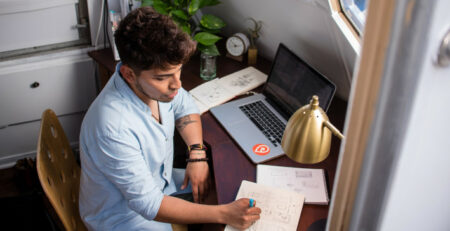Teambuilding for Designers: 101
Healthy office culture forms the bedrock for design teams to excel in their endeavors. Engaging in graphic design exercises such as brainstorming, idea-sharing, and work critiques becomes more impactful within a setting where individuals are familiar and at ease with one another. This familiarity fosters an environment where team members are more inclined to express candid opinions without fear of causing offense.
Crafting an effective team of designers requires a nuanced approach compared to team-building in other professional contexts. Creativity is deeply intertwined with individual personalities, necessitating a more personalized approach to team-building. Graphic design exercises, tailored to the unique traits of team members, become instrumental in establishing a cohesive and innovative design team.
Both managers and designers can leverage the insights provided in this guide to institute and maintain an open, friendly, and productive community of creatives. The incorporation of graphic design exercises into team-building efforts enhances not only collaboration but also the overall creative output of the design team.
What is Teambuilding?
Teambuilding exercises are too frequently confused with any kind of social interaction between coworkers outside of the workplace. More than being just an opportunity for people to get to know each other (which is also important), teambuilding for designers generally includes four different kinds of activities:
- Goal-Setting
Laying out a plan of action is essential for any team and doubly so for designers. Brainstorming and defining what success and failure might look like will help everyone stay on the same page and make for much more effective design work.
In some sense, the central goal is always to translate business goals into a product that will drive users toward a call to action. If you can learn how to determine concrete goals and benchmark stages as a team, that entire process will be more intuitive and streamlined.
- Interpersonal Relations
Universal respect and trust should be a common practice when working with designers. Even if there are ideological, personal, or political disagreements on the team, everyone should have enough respect for the work and their coworkers to continue problem-solving in a rational, professional manner.
Learning how to share with one another and support teammates to resolve conflicts and disputes will keep everyone happy and the office dynamic as drama-free as possible. Teambuilding facilitates all these factors as well as demonstrating how the team can use a common mediator to address problems.
- Problem-Solving
Just like they have to do to solve design problems as effectively as possible, members of an art department or design team should also learn how to work together to address the problems they’ve identified. This might include leadership training and identifying personal strengths and weaknesses, or it could be more task-oriented.
This is one of the biggest parts of design work and therefore also one of the key aspects of teambuilding for designers. At the end of any exercise, participants should feel empowered to tackle any problem as a team.

- Role Clarification
Clarity regarding each team member’s responsibilities and duties will help foster a more forgiving and understanding attitude in the workplace. Beyond simply identifying their roles, participants might also act out the roles of others so that everyone can understand the entire structure of the team.
Role clarification can also help everyone understand the office hierarchy. Make sure everyone knows who they should go to to resolve disputes and get permission for risk-taking actions before they pull the trigger.
Common Goals of Teambuilding
These stages have several goals whether you’re working with designers at a corporation or a small agency. The team should define itself and its purposes to make sure it can stay on task and complete its objectives easily. Leadership should be clearly defined and agreed upon as well.
A general code of conduct and consequences should be described and agreed upon, although many companies have a specific section of their onboarding process that accomplishes this task well before teambuilding begins.
As far as the work itself goes, ensuring everyone is contributing to a project and taking ownership of their actions is very important. Communication methods should be outlined and illustrated so everyone understands them.
One aspect of team building that is frequently overlooked is how and who to ask for help if you need it. Construct your team strategically so that everyone has at least one other person they can go to if they get in over their head or simply cannot think of a solution to a problem.
Does Team Building Work?
Don’t expect team members who have issues with communication or a lack of respect for others to magically turn into superstar employees after a few teambuilding exercises. However, the majority of employees do benefit from teambuilding because they receive explicit information that they can continue to use for a long time to come.
If your goal is to get everyone on the same page and speaking frankly about goals, problems, and solutions, then teambuilding is a good idea. Some companies try to make a big splash by spending tons of money on fancy company outings, but a simpler exercise will very likely have a similar effect.
8 Common Teambuilding Exercises
If you want your teambuilding exercises to work you have to choose something everyone will legitimately enjoy and not view as an unwelcome interruption of their busy work schedule. Here are a few common teambuilding exercises you can try:
1- Honest Penny
This game is quick enough to break the ice before a meeting but you can also use it as part of a longer team-building session. All you need is a pile of pennies with years between 5 and 30 years old, depending on the average age of the group you’re working with.
Each person takes a penny at random and tells a story about something that happened to them during that year. It’s a great way to learn things from your coworkers that generally don’t come up in meetings. If you want to make it more design-centric, you can ask for design-related stories and use younger pennies.
2- Picture Book
For a game that requires a bit more creative thinking, you can assemble a series of photos and dole one out to each participant. Instruct them to hide their photos so no one can see what they look like, then ask everyone to make a story with their pictures by describing their own.
This is a fun game for designers because they likely already have a good sense of storytelling. You can make the photos as absurd and comedic as you like to get everyone laughing.
3- Human Tangle
Have all the participants stand around in a circle shoulder-to-shoulder. Make sure everyone is comfortable with physical contact before you begin. The goal is for everyone to hold the hands of two other people besides the ones immediately next to them without breaking the circle.
The solution to this challenge isn’t immediately apparent, but once people start to understand the pattern they should be able to build a continuous knot in no time.
4- Escape Rooms
One of the biggest teambuilding trends in the past few years is escape rooms, which are frequently set up to resemble apartments or laboratories that participants have to escape with the use of hints and clues. These rooms are great for problem-solving and learning to communicate and strategize with one another.
The only drawback to escape rooms is that they’ll probably require a longer commitment. Everyone will have to travel to one, which means time off work. But if you’re building a longer teambuilding session, escape rooms could be a great idea.
5- Categories
Designers will love this game because it challenges them to look at everyday objects in a new way. All that’s needed is a random assortment of things, different enough to make the teams think. You can use objects from around the office or you can use completely unrelated things.
The excuses people find to group certain objects together often lead to hilarious results. If you want to add another dimension of discussion to this game, you can include a mechanism for debating other teams’ categories or the inclusion of certain objects in a given category.
6- New and Improved
You can get a second game out of the random assortment of objects you used in the categories game. Instruct teams to select one object and make them design a complete ad campaign for the object, including slogans, logo designs, and branding package.
Designers can let their talents shine through in this game. Those with some copywriting experience will have catchier slogans and product designers will likely have a more inventive design. Best of all, since it’s so low-stakes, designers can use this game to lampoon certain aspects of the industry or make jokes about design.
7- Egg/Water Balloon Toss
A simple game a few people might remember from summer camp, a tossing game can also be tailored to be more applicable to designers. For example, rather than simply tossing the egg or water balloon back and forth, participants can be instructed to build something for catching the object without it breaking.
All you need to do to play the original game is one egg or balloon per person. Pairs face each other and toss the object, taking one step back each round. If you have limited resources, you can also have everyone stand around in a circle and toss one object to a random person across the circle.
8- Helium Stick
This is a great group activity for everybody and it doesn’t necessarily require the use of words. A helium stick for this particular task will have to be purchased, however. A helium stick is a long, thin rod that is filled with helium so that it floats slightly.
Have the team stand in two lines facing one another. They should put out both index fingers so that the stick can rest on them. The stick must stay in contact with everyone’s fingers the whole time as they attempt to lower it to the ground.
8 Teambuilding for Designers Who Work Remotely
Perhaps half of the activities we just named won’t translate to design teams that are completely or partly remote. Games that remote teams can play have to operate on imaginative games and talking with one another. Here are a few different options for teams working with designers in remote locations:
1- Two Truths & A Lie
The concept of this game is simple enough but it might not work for teams of people who haven’t known each other for very long. Each participant shares three statements, two of which should be true while the remaining one is not. Few games offer the opportunity to share personal stories like this one does and since it doesn’t require any materials at all you can easily adapt it for digital teams.
2- Desert Island
In this game, individuals or teams are instructed to take a list of things they might need if they were trapped on a desert island and place them in order of priority. Discussion is an important part of this game, so if you don’t have enough people to make teams then you should build in a discussion session afterward for people to discuss why they made their decisions.
3- Just One Question
Participants should be given a list of different situations as individuals or teams depending on the number of people you have. For each person’s scenario, the others can ask just one question to determine if they’re qualified and prepared to face the hypothetical event to come. At the end, everyone votes on who asked the best question for each situation.
4- Bucket List
Allow everyone a few minutes to come up with several things that are on their bucket list – things they want to do before they die. Go around the team and have people share what they put on their list. This is a great way to get to know people’s values and personalities.
5- Elimination
For this discussion-based game, small teams or individuals work fine. Start with a random comparison of two things that are fairly similar like bagels and doughnuts. Everyone must decide which one the world can keep and which will disappear forever. Continue as many rounds as you like with the winner of each round opposing a new object until it is eliminated.
6- Judgment Day
This game can go on for a while, especially if the topics chosen are interesting. Before the teambuilding session, instruct designers to choose a favorite website that features a design that they love. Go around and have people share links and explain why they like it and let other people make comments. The best part about this game is that it’s happy-hour-friendly if that fits into the office culture.
You can also use current office projects if the team is comfortable and interested in critiquing each other’s ideas and providing constructive criticism.
7- Arm’s Reach
Give each participant one minute to find an object within arm’s reach and invent a story about it. It could be a real story or a completely absurd piece of fiction, just so long as it’s relatively cohesive. If people are slow to talk, give them some pre-defined questions that their story has to answer to keep things moving along.
8- Guess Who?
For this game to work on a digital platform, the facilitator has to coordinate a fair bit. Ask each participant to send you the name of a famous person or character who is well-known enough for people to recognize the name. Then, dole them out to each person, making sure no one gets their own.
Go around one by one asking yes or no questions to learn who each person is. Each person can continue asking questions until they get “no” as a response. The funniest results come when people fail to recognize their own submissions.

Teambuilding Mistakes
Some managers hear about teambuilding and try to fit it in immediately at their next meeting. That can be fine, but if the team is already busy or know each other well enough, a teambuilding session can be boring or frustrating.
Working with designers means there could well be a few introverts on the team and every effort should be made to include them in the activity. Don’t force them, but make sure to ask them enough questions that they can contribute as well.
Teambuilding for designers is always more effective when the participants can demonstrate their creativity in a way that feels authentic and not forced. The most important thing to consider before holding teambuilding for designers is the office culture. Make sure everything is in keeping with the vibes at the workplace (real or digital) and everyone is happy to participate.
Many people who try teambuilding jump right to the flashier exercises that center on booze or sports. That might be perfect for your office, but make sure you’re tapping into a common interest so no one is left out.
For example, drinks can be included but they shouldn’t be required or the central goal. Similarly, don’t expect the whole office to be interested in team sports if their ages skew older or nerdier.
Conclusion:
Design team members have to be familiar and comfortable with one another to produce their best work. Teambuilding can help create more honest brainstorming and critiques as well as prompt the whole team to come up with more imaginative solutions.
Even if you’re on a remote design team, there are plenty of ways to get people learning about themselves, each other, and design thinking. The advice and activities in this guide to teambuilding for designers should help bring the whole design team together in meaningful ways.











